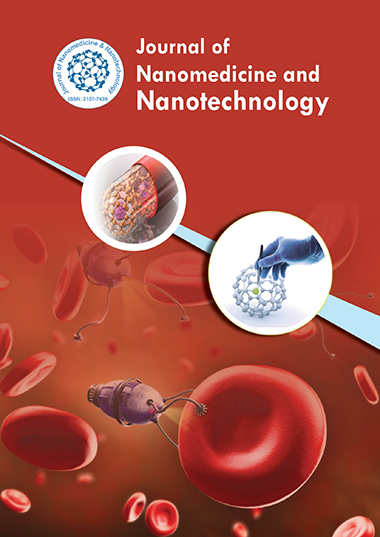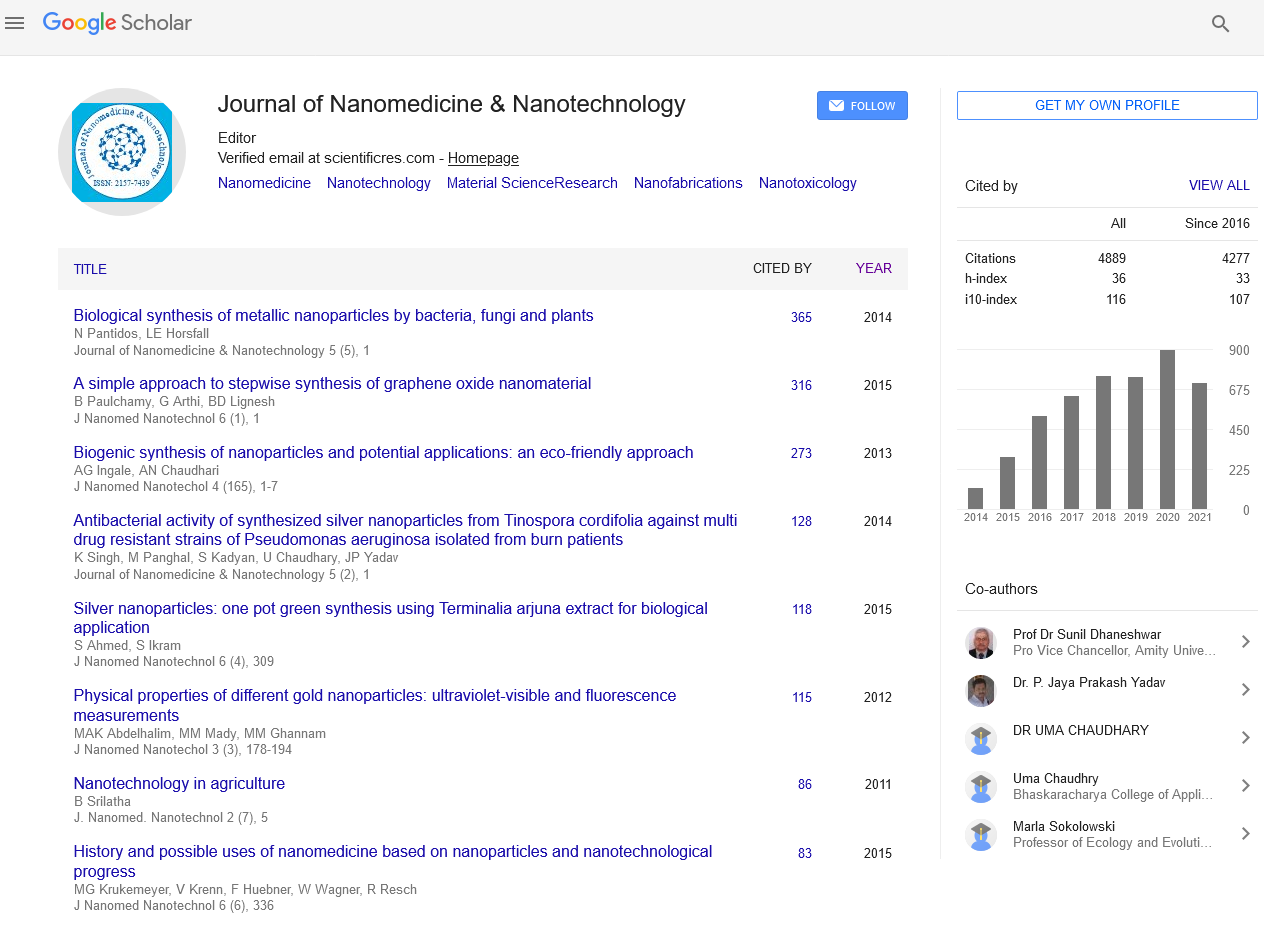Indexed In
- Open J Gate
- Genamics JournalSeek
- Academic Keys
- JournalTOCs
- ResearchBible
- China National Knowledge Infrastructure (CNKI)
- Scimago
- Ulrich's Periodicals Directory
- Electronic Journals Library
- RefSeek
- Hamdard University
- EBSCO A-Z
- OCLC- WorldCat
- SWB online catalog
- Virtual Library of Biology (vifabio)
- Publons
- MIAR
- Scientific Indexing Services (SIS)
- Euro Pub
- Google Scholar
Useful Links
Share This Page
Journal Flyer

Open Access Journals
- Agri and Aquaculture
- Biochemistry
- Bioinformatics & Systems Biology
- Business & Management
- Chemistry
- Clinical Sciences
- Engineering
- Food & Nutrition
- General Science
- Genetics & Molecular Biology
- Immunology & Microbiology
- Medical Sciences
- Neuroscience & Psychology
- Nursing & Health Care
- Pharmaceutical Sciences
Short Communication - (2025) Volume 16, Issue 2
Revolutionizing Medicine and Technology through Nanoengineering
Magnolia O Hara*Received: 01-Mar-2025, Manuscript No. jnmnt-25-28605; Editor assigned: 05-Mar-2025, Pre QC No. jnmnt-25-28605 (PQ); Reviewed: 20-Mar-2025, QC No. jnmnt-25-28605; Revised: 25-Mar-2025, Manuscript No. jnmnt-25-28605 (R); Published: 31-Mar-2025
Abstract
Nanoengineering is an interdisciplinary field that applies principles of nanotechnology to design and manipulate materials at the atomic and molecular scale for applications in medicine, electronics, and advanced manufacturing. This innovative discipline has led to groundbreaking advancements in targeted drug delivery, regenerative medicine, nanoelectronics, and sustainable energy solutions. By enabling precise control over material properties, nanoengineering enhances efficiency, miniaturization, and functionality in numerous sectors. However, challenges related to scalability, safety, and regulatory frameworks must be addressed to fully realize its potential. This article explores the impact of nanoengineering on medicine and technology, its key developments, challenges, and future prospects.
Keywords
Nanoengineering; Nanotechnology; Drug delivery; Regenerative medicine; Nanoelectronics; Nanomaterials; Biomedical engineering; Smart devices; Sustainable energy; Advanced manufacturing
INTRODUCTION
Nanoengineering is revolutionizing various scientific and industrial domains by offering unprecedented control over materials at the nanoscale. By manipulating matter at dimensions smaller than 100 nanometers, researchers can enhance mechanical, electrical, and biological properties, leading to major innovations in healthcare, electronics, and environmental sustainability. This field has gained immense traction due to its potential to solve complex problems, from treating incurable diseases to developing next-generation computing technologies. This article provides an overview of nanoengineering’s applications in medicine and technology, highlighting its transformative impact and challenges [1,2].
DESCRIPTION
Nanoengineering encompasses a broad spectrum of techniques, including nanofabrication, self-assembly, and molecular engineering. It enables the creation of highly functional materials with tailored properties. Some of the key areas influenced by nanoengineering include [3,4].
Medicine and healthcare: Nanoengineered drug delivery systems, such as liposomes and polymeric nanoparticles, allow for precise targeting of diseased cells, reducing side effects and improving therapeutic outcomes. Regenerative medicine benefits from nanoengineered scaffolds that support tissue regeneration and wound healing. Additionally, nanosensors enable early disease detection through highly sensitive diagnostic tools [5,6].
Electronics and computing: Nanoengineering has played a pivotal role in the miniaturization of electronic components, leading to faster, more efficient processors and memory storage devices. Quantum dots and nanotransistors are paving the way for next-generation nanoelectronics, improving computing power and energy efficiency.
Sustainable energy solutions: Nanostructured materials enhance the performance of solar cells, batteries, and supercapacitors, making renewable energy more efficient and accessible. Nanoengineering techniques are being used to develop lightweight, high-performance materials for energy storage and conversion systems [7,8].
Advanced manufacturing and smart materials: Smart materials engineered at the nanoscale exhibit self-healing properties, shape memory effects, and responsiveness to environmental stimuli, finding applications in aerospace, automotive, and wearable technology [9,10].
DISCUSSION
Despite the transformative potential of nanoengineering, several challenges must be addressed to ensure its safe and ethical implementation. One of the major concerns is the biocompatibility and toxicity of nanomaterials. Due to their small size, nanoparticles can enter biological systems and accumulate in organs, necessitating extensive research on long-term effects and safety regulations.
Scalability is another key issue. While nanoengineering has demonstrated remarkable capabilities in laboratories, mass production of nanomaterials and devices remains complex and costly. Standardized manufacturing processes and regulatory guidelines are crucial to facilitating commercialization and large-scale application.
Ethical and societal implications also play a significant role. The integration of nanoengineering in medicine and technology raises concerns about privacy, data security, and potential misuse. Developing comprehensive policies to govern nanoengineering applications is essential for responsible innovation.
CONCLUSION
Nanoengineering is at the forefront of technological and medical advancements, offering groundbreaking solutions for drug delivery, regenerative medicine, electronics, and sustainable energy. While challenges such as toxicity, scalability, and ethical considerations persist, ongoing research and regulatory efforts will help overcome these barriers. The continued evolution of nanoengineering holds the promise of reshaping industries and improving quality of life globally. By fostering interdisciplinary collaboration and responsible innovation, nanoengineering will remain a key driver of scientific progress in the 21st century.
ACKNOWLEDGEMENT
None
CONFLICT OF INTEREST
None
REFERENCES
- Schleich N, Sibret P, Danhier P, Ucakar B, Laurent S, Muller R N, et al. Dual anticancer drug/superparamagnetic iron oxide-loaded PLGA-based nanoparticles for cancer therapy and magnetic resonance imaging. Int J Pharm. 2014;466(1-2): 172-185.
- Miller K D, Nogueira L, Mariotto A B, Rowland J H, Yabroff K R, Alfano, et al. Cancer treatment and survivorship statistics, 2019. CA Cancer J Clin. 2020; 69(5): 363-385.
- Lee S, Patel T. Tumor-Targeted Drug Delivery Utilizing Engineered T Cells. Frontiers in Immunology. 2018; 9: 2294.
- Garcia J R, Davis J. Probing Targeted Nanoparticle Surface Interactions with Cellular Membranes. ACS Nano. 2019; 13(8): 9137-9151.
- Parker N, Smith A. Multiple Myeloma Antibodies and Targeted Therapies. Hematol Oncol Clin North Am. 2019; 33(1): 37-55.
- Smith A M, Lee K. Conjugated Polymer Nanoparticles for Imaging and Therapeutics. Bioconjugate Chemistry. 2022; 33(1): 1-13.
- Brown M, Anderson R, Artis D. Intestinal Memory CD4+ T Cells Function to Suppress Inflammation in the Gut. Journal of Immunology. 2018; 187: 16-187.
- Anderson J C, White K A. Structure of the African swine fever virus major capsid protein p72. Cell Reports. 2021; 36(7): 109454.
- Johnson D E, O'Keefe R A, Grandis J R. Targeting the IL-6/JAK/STAT3 signalling axis in cancer. Nat Rev Clin Oncol. 2022;19(3): 208-222.
- Smith A M, Davis J. Increasing the accuracy of nanoparticle sensing using a multi-level gating approach. Nature Communications. 2019; 10(1): 1-9.
Indexed at, Google Scholar, Crossref
Indexed at, Google Scholar, Crossref
Indexed at, Google Scholar, Crossref
Indexed at, Google Scholar, Crossref
Indexed at, Google Scholar, Crossref
Citation: Magnolia O (2025) Revolutionizing Medicine and Technology through Nanoengineering. J Nanomed Nanotech. 16: 781.
Copyright: ©2025 Magnolia O. This is an open-access article distributed under the terms of the Creative Commons Attribution License, which permits unrestricted use, distribution, and reproduction in any medium, provided the original author and source are credited.


